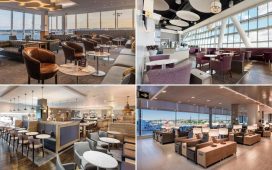Ponga
The concejo (council) of Ponga, south-west of the Picos de Europa national park, is a protected natural area recently singled out for biosphere reserve status by Unesco for its stunning landscape and fascinating rural traditions. Lovers of wild nature are drawn here by the beech woods of Peloño, the mountain peaks of Tiatordos and Pierzu, and the river gorges of Viboli – one of Spain’s top spots for canyoning. Connoisseurs of rural life, meanwhile, head for off-piste villages like pretty Sobrefoz, or check out the Ecomuseum in San Juan de Beleño, Ponga’s diminutive capital. Whatever you’re into, Ponga is quintessential Asturias.
Pre-Romanesque architecture in Oviedo



Oviedo – or in the local parlance, Uviéu – is the capital of Asturias, and harbours some of Spain’s most venerable buildings, including the magical Cámara Santa (holy chamber), part of Oviedo cathedral, and San Julián de los Prados, a tiny church dating from the 8th century whose richly coloured interior reminds you what a debt Christianity owes to the Orient. The triple arches of Santa María del Naranco, a pre-Romanesque masterpiece set in green pastures above the city, have become an emblem of Asturian history and culture. Chapel, palace, hunting lodge, or pleasure-dome? Santa Maria was built for King Ramiro I in the mid-9th century, but the true purpose of this enigmatic building may never be known.
Fabada asturiana

The faba is a type of large white bean indigenous to Asturias and symbolic of the region’s honest-to-goodness, flavour-packed cuisine. A common sight in vegetable gardens, where the plants climb on poles, these big beans are the main ingredient of a potent stew with morcilla (blood sausage), chorizo and smoked bacon: the fabada asturiana. Around the dish bubbles a rich local culture of anecdote and myth, mostly based around its (in)digestibility. Finding fabada is no problem – you’ll see it on menus everywhere – but Casa Gerardo in Prendes and Casa Marcial in Parres, two of the region’s best restaurants, offer exquisite updated versions.
Desfiladero del Rio Cares

Hikers and trekkers are spoiled for choice in the principality, but here is a sure-fire highlight. This easy seven-mile walk follows the Cares River down a dramatic mountain gorge. The route begins at Poncebos and ends in the village of Caín – which for centuries was largely cut off from the outside world. The Cares gorge itself is a gloomy canyon with a walking path carved out of the rock face. From below comes the muffled thunder of the river, while far above the cliffs can be glimpsed the sparkling summits of the Picos de Europa.
Playa de Torimbia

Asturian beaches commonly feature on lists of Spain’s most perfect playas. There’s Barayo, for instance, a pristine coastal valley where a river reaches the sea in a majestic arc of sand; and Playa del Silencio, aptly named, with dramatic rock formations encircling a lonely beach. Loveliest of all is surely Torimbia (near the village of Llanes), a curving bay of fine golden sand, unspoilt and sublimely beautiful. Like many of the world’s best beaches, this one can only be reached on foot (it’s an easy 15-minute walk down). Bring whatever you need, but you might not need to have clothes or swimmers on your list – naturists as well as nature-lovers are welcome here.
Sidra


Apple orchards replace vineyards in this temperate northern region, where the drink of choice is not wine, but cider. Here it’s served escanciada: the barman pours the cider from head height or higher into a glass held at the waist, oxygenating the drink for a kick of freshness that Asturians love. (The sidra is downed in one, but a little is always left at the bottom of the glass, custom dictating that this must be thrown out on to the floor.) Sidrerías are classic local institutions serving bottles of fresh cider along with plates of fried monkfish, smoked chorizo, and slabs of delicious local cheese.
Parador de Corias
An 11th-century monastery among the woodlands and rivers of Asturias’ deep south houses, this hotel is a recent addition to the state-run Parador chain. The building is a lofty expression of regional art and culture – especially the monastery church, which contains the austerely beautiful 12th-century Cristo de la Cantonada, a long-haired and gold-crowned figure of Christ. The Parador also brings you up close with one of Spain’s most astounding landscapes: the astonishingly verdant Muniellos, home to Europe’s largest extension of virgin oak forest.
Niemeyer in Avilés

The city of Avilés was once an industrial powerhouse: then came pollution and post-industrial neglect. Now, a futuristic cultural centre designed by Brazilian architect Oscar Niemeyer, which opened in 2011, signals the immense positive changes that have come to the city. A series of curvaceous white forms includes an auditorium for open-air concerts, a viewing tower with a spiral staircase and a spectacular domed exhibition space – all arranged around a central plaza that the great Brazilian (103 at the time) described as “a place for cohabitation, education, culture and peace”. Niemeyer has done for Avilés what Guggenheim did for Bilbao.
Cabrales

Blessed with rich pastures and a temperate climate, Asturias is a rich hunting-ground for cheese-freaks. With an estimated 40 different types produced within its borders, three of which have Denominación de Origen Protegida status, few places in the world can boast such a variety of cheeses over such a modest geographical area. Deep-flavoured cabrales is up there with roquefort and stilton as one of the world’s great blue cheeses. It packs a powerful punch, and often benefits from a good draught of sidra to soften its piquant aftertaste. You’ll find this fragrant fromage all over the region, but the town of Cabrales itself, among the Picos de Europa mountains, has Asturias’ largest concentration of artisan cheesemakers.
‘El surf’

Ever since the 1960s when surf culture kicked off in the region, Asturias has been an international draw for riders of big Atlantic waves. There are all-year-round scenes at prime surf-sites like Rodiles (in Villaviciosa), Santa Marina (Ribadesella) and the gorgeous swathe of wild beach that is Peñarronda (Castropol). Playa de la Grande, in Tapia de Casariego at the region’s western end, often hosts European surfing championships. Meanwhile San Lorenzo, in the surf-mad coastal city of Gijón (or Xixón in Asturian), is a good choice for beginners thanks to its reliable breakers, great facilities, and “surf camps” such as Siroko, 10 minutes from the beach.
Tempted to embark on your own Asturian cheese, surf and cider odyssey? Visit Turismo Asturias













